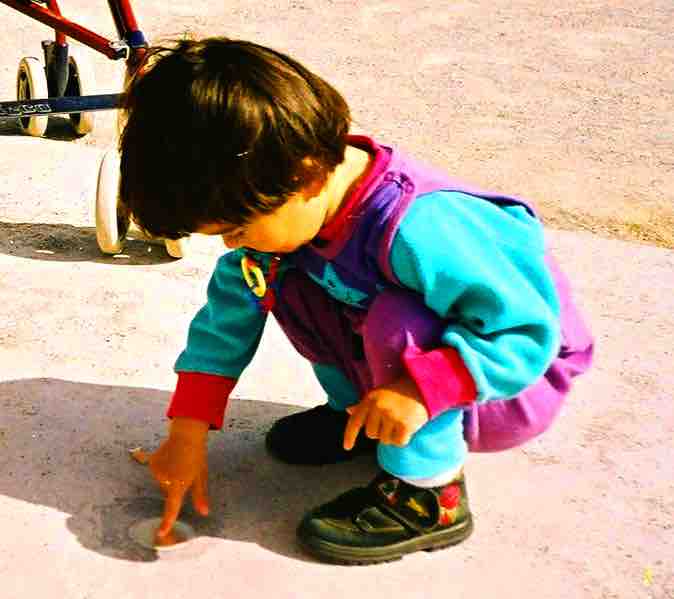Infants and children grow and develop at a rapid pace during the first few years of life. The development of both gross and fine motor skills helps a child go from a completely dependent newborn to an independently functioning toddler in about a 3-year span.
Gross versus Fine Motor Skills
Motor skills refer to our ability to move our bodies and manipulate objects. Gross motor skills coordinate the large muscle groups that control our arms and legs and involve larger movements like balancing, running, and jumping. By the end of the second year of life, most children (except those with disabilities or other special needs) can stand up, walk/run, climb stairs, jump, and skip. As children grow older (ages 4-5), many can also catch balls, ride bikes, and run with more speed and agility. The prerequisite to all these skills is postural control—the ability to hold one's head up, sit independently, and stand. Appropriate posture allows the child to learn to walk, run, and engage in other gross motor skills.
Fine motor skills, by contrast, involve the coordination of small muscle movements, usually involving the hands working in coordination with the eyes. Hand-eye coordination allows a child to perform such skills as drawing, using buttons and zippers, eating with utensils, and tying shoes. Children increase their mastery of these skills through practice. For example, at age 2, a child's drawing might be a series of crayon scribbles, but by age 5, he or she might be able to draw a person's face complete with eyes, nose, and mouth.
Physical Milestones
As stated above, children grow very quickly and meet physical milestones rapidly in the first few years of life. The following is a list of the major milestones that occur in children during those first formative years.
Up to 24 months:
- Crawls skillfully and quickly
- Stands alone with feet spread apart, legs stiffened, and arms extended for support
- Gets to feet unaided
- Can walk unassisted near the end of this period; falls often; is not always able to maneuver around obstacles, such as furniture or toys
- Uses furniture to lower self to floor; collapses backwards into a sitting position, or falls forward on hands and then sits
- Enjoys pushing or pulling toys while walking
- Repeatedly picks up objects and throws them; direction becomes more deliberate
- Attempts to run; has difficulty stopping and usually just drops to the floor
- Crawls up stairs on all fours; goes down stairs in same position
- Enjoys crayons and markers for scribbling; uses whole-arm movement
- Helps feed self; enjoys holding a spoon (often upside down) and drinking from a glass or cup; not always accurate in getting utensils into mouth; frequent spills should be expected
- Helps turn the pages in book
- Stacks two to six objects per day
Up to 3 years:
- Walks up and down stairs unassisted, using alternating feet; may jump from bottom step, landing on both feet
- Can momentarily balance on one foot
- Can kick big ball-shaped objects
- Needs minimal assistance eating
- Jumps on the spot
- Pedals a small tricycle
- Throws a ball overhand; aim and distance are limited
- Catches a large bouncing ball with both arms extended
- Shows improved control of crayons or markers; uses vertical, horizontal and circular strokes
- Holds crayon or marker between first two fingers and thumb (tripod grasp), not in a fist as earlier
- Can turn the pages of a book one at a time
- Enjoys building with blocks
- Builds a tower of eight or more blocks
- Enjoys playing with clay; pounds, rolls, and squeezes it
- May begin to show hand dominance
- Manipulates large buttons and zippers on clothing
- Washes and dries hands; brushes own teeth, but not thoroughly
By age 6:
- Gains greater control over large and fine motor skills; movements are more precise and deliberate, though some clumsiness persists
- Enjoys vigorous running, jumping, climbing, and throwing etc.
- Span of attention increases; works at tasks for longer periods of time
- Can concentrate effort but not always consistently
- Has fun with problem-solving and sorting activities like stacking, puzzles, and mazes
- Enjoys the challenge of puzzles, counting, and sorting activities, paper-and-pencil mazes, and games that involve matching letters and words with pictures
- Recognizes some words by sight; attempts to sound out words
- Increased functioning which facilitates learning to ride a bicycle, swim, swing a bat, or kick a ball
- Able to trace objects
- Folds and cuts paper into simple shapes
- Can tie laces, string (like shoes)

Toddler exploring her world
By manipulating the world around them, children learn and grow physically in both gross and fine motor skills.